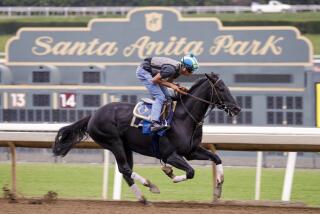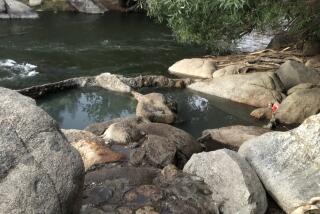Ultra runners frustrated by Badwater race’s move away from Death Valley
For 27 straight summers, all that stood between runners and completion of the Badwater Ultramarathon was 135 miles of asphalt, a 13,000-foot elevation gain and late July temperatures that soared to 120 degrees and above.
They called it “the toughest foot race in the world.” And not too many people argued.
But this summer, the race from the depths of Death Valley to the shoulders of Mt. Whitney has been moved, while the National Park Service conducts a “safety assessment” of the run and other athletic events. Race organizers have reconfigured one of the marquee competitions in ultra-distance running and moved it to an alternate course that will criss-cross the Owens Valley, dozens of miles to the west.
The move away from Death Valley National Park and the namesake Badwater Basin has stunned the close-knit family of ultra runners and triggered complaints to the Park Service and Interior Department. Some accuse the government of a “nanny state” overreach.
“It’s a disaster,” said five-time Badwater competitor Shannon Farar-Griefer, who said the change would be tantamount to moving the Tour de France finish off the Champs-Elysees. “This is the granddaddy, the premier event. And it’s in one of the greatest places in the world — a place to see where your body can go and where your mind can go.”
Inyo County officials and others who support the race say they don’t object to the safety review of the stomach-churning, shoe-burning odyssey, which traditionally begins at the lowest point in the U.S., finishes on the slopes of the highest peak in the Lower 48 and has a field limited to 100 men and women.
But backers of the run question why the new superintendent of Death Valley National Park couldn’t have conducted the safety review in conjunction with the July 21 run and other events, like the Furnace Creek 508. That is the landmark bicycle ride that for 25 years has taken cyclists through Death Valley, on a 508-mile route that begins in Santa Clarita and ends in Twentynine Palms.
Kathy Billings, superintendent of Death Valley, announced last year that the park would take applications only for events after Oct. 1, 2014, allowing time to complete the safety review. In a December letter, she said athletic events in recent years have posed safety risks and triggered “multiple near misses,” most notably with support vehicles connected to the races. The assessment will look into the impact on participants, park visitors and employees.
Billings, who has been at her post for less than a year, has told the operator of the Badwater run and others that the park is receiving an increasing number of applications for special athletic events. One man who has completed a mile run in a Darth Vader costume during the peak heat of summer has said he wants to obtain a permit for a more organized event. It would include other “Star Wars”-costumed runners and be called the “Darth Valley Challenge.”
Park officials across the U.S. have reported facing similar trouble in trying to balance the wants of endurance aficionados and other park users.
Billings declined to comment but Death Valley park spokeswoman Cheryl Chipman said multiple issues arise when athletes and their crews descend on the desolate park, which hosts 1 million visitors a year. The teams can slow access around the park and create traffic “havoc,” particularly when tourists stop to take photos, Chipman said. At one recent event, a support-vehicle driver fell asleep and veered across the narrow road into the gravel, said the spokeswoman. She declined to name the event.
“We don’t want to wait until there is a serious accident,” Chipman said, “which is usually what propels these kinds of reviews to happen.”
Chris Kostman, who operates the Badwater run, Furnace Creek bike race and three other Death Valley events, called it “mind-blowing” and “unprecedented” to have to cancel or relocate the competitions, given that they have had no deaths, serious accidents or citations over 24 years. (The Park Service does not dispute the events’ clean safety records.)
Kostman, a Woodland Hills-based operator of AdventureCorps Inc., met with Billings in December. Members of his team and Inyo County officials tried to persuade the national park official to let the events go ahead this year.
They also suggested immediate changes to reduce impact — including cutting Badwater support crews from six to four people and requiring them to operate in one car, instead of two. Inyo County administrator Kevin D. Carunchio told the Park Service that county workers could help speed up the safety review.
But Billings said she wasn’t open to negotiation, meeting participants said.
Frank McKinney, an eight-time Badwater run participant, said he has come to love Death Valley as “the most beautiful national park in the country.” Despite living in Florida, where he is a home builder, McKinney recently joined the board of the nonprofit Death Valley Natural History Assn., which supports the park.
Though he said he understands the need to assure safe public events, he has been disappointed by Billings’ unbending stance. “She has her own little fiefdom like any national park superintendent,” McKinney said. “With just one stroke of her pen, one person can omnipotently wipe out this event, after 27 years, and all these other events.”
More than 1,800 people have joined a “Save Sporting Events in Death Valley!” Facebook page. And supporters have noted that previous superintendents came out to cheer the runners.
Spokeswoman Chipman said Billings is not opposed to athletic events but simply “wasn’t comfortable” continuing events without completion of the safety review and potential “mitigation efforts.” While much of the focus of discussions has been on the challenge created by support crews, the Park Service also has signaled concern about the health of extreme athletes.
The Badwater run’s permit requires it to release the medical records kept by its support crew, which last year included eight doctors, three nurses, four emergency medical technicians and an exercise physiology professor, to monitor about 90 runners. “We have not seen those records yet,” Chipman said. “They say they don’t have problems, but we really don’t know.”
It is unclear what standard the review contemplates, if any, for the physical well being of runners who plod over asphalt that can reach 180 degrees or more. A journalist who covered the race not long ago described air so hot that breathing felt like sucking on a hair dryer. The burning July asphalt has been known to melt the soles right off shoes.
Runners say they understand they are putting their bodies under extreme distress. But they describe an almost mystical attachment to the locale and the allure of running through some of the world’s most intense heat, from lowest point in the U.S. toward one of the highest. They also say their condition is monitored more closely at Badwater than at any other ultra-endurance run.
With a permit for the July 21 race impossible to obtain this year, Kostman’s new version of the race will still cover 135 miles, but now starting in Lone Pine, finishing at Whitney Portal and requiring long jaunts to the west (Horseshoe Meadows, elevation 9,900 feet) and east (Cerro Gordo ghost town, elevation 8,153.)
With even more elevation gain than Badwater but not the same heat, the new event is expected to draw some of the faithful “family” of ultra regulars. But they will miss Badwater — the extreme pain, the shooting stars overhead at 2 a.m., the flyovers by military jets.
“You want to test yourself, to go through Death Valley in July, when it is one of the hottest places in the world,” Farar-Griefer said. “That is the thrill. That is the joy of it.”
More to Read
Start your day right
Sign up for Essential California for news, features and recommendations from the L.A. Times and beyond in your inbox six days a week.
You may occasionally receive promotional content from the Los Angeles Times.







